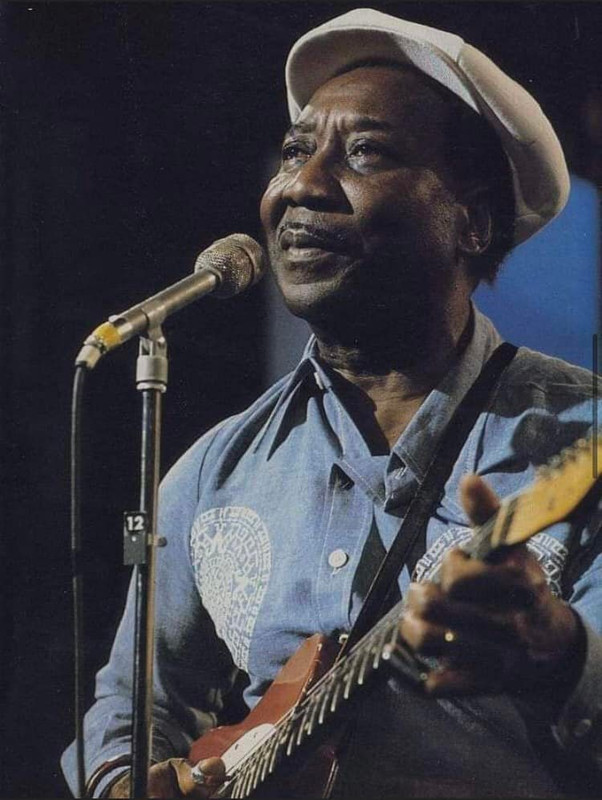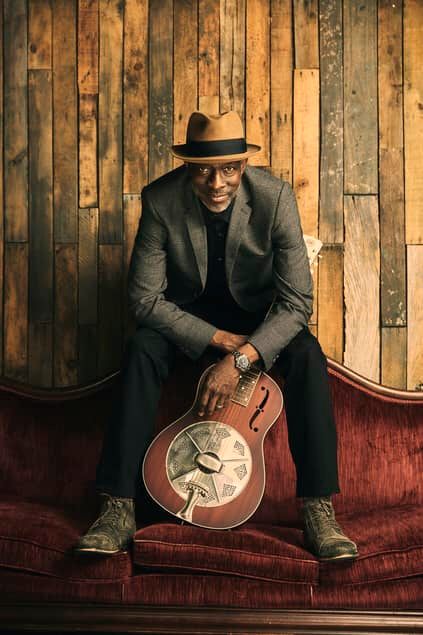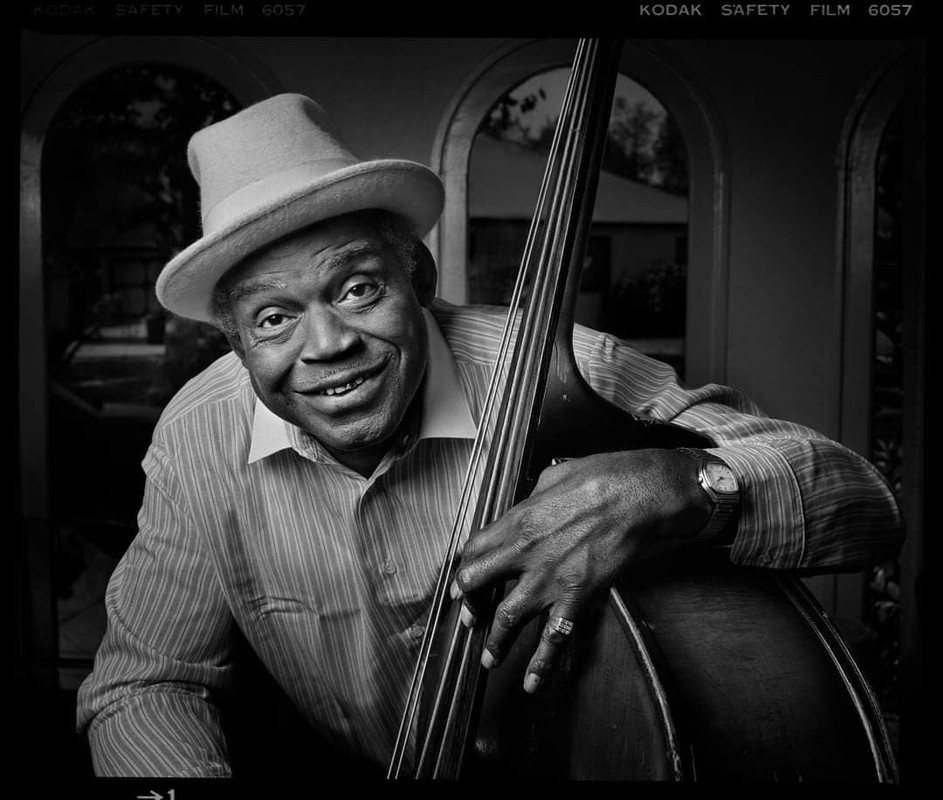
Η Φωτογραφία της ημέρας.
Re: Η Φωτογραφία της ημέρας.
Lightnin’ Hopkins.
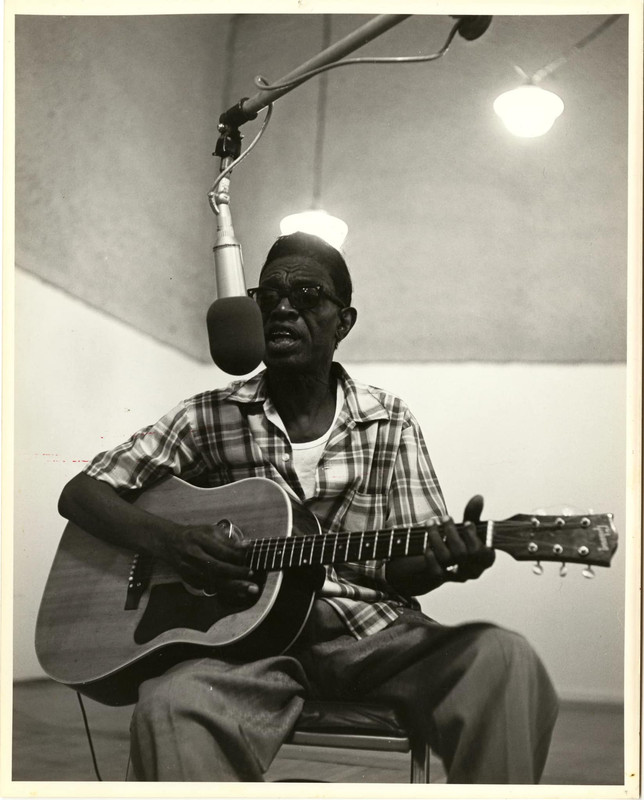
“So we went over there and there he was just ferociously playing on his electric guitar and singing really powerful stuff, it was just really, really amazing. And shortly after we had come in, he just segued during his singing by pointing his hand at me and singing “Whoa, this man come all the way from California just to hear poor Lightnin’ sing.” Then he went on about this song about how he was aching and his shoulder was hurting him, because his rheumatism was bothering him, and he was just making up this poetry about what was in his head that day, you see? I had never encountered anything like that.” – Chris Strachwitz on first meeting Lightnin’ Hopkins.

“So we went over there and there he was just ferociously playing on his electric guitar and singing really powerful stuff, it was just really, really amazing. And shortly after we had come in, he just segued during his singing by pointing his hand at me and singing “Whoa, this man come all the way from California just to hear poor Lightnin’ sing.” Then he went on about this song about how he was aching and his shoulder was hurting him, because his rheumatism was bothering him, and he was just making up this poetry about what was in his head that day, you see? I had never encountered anything like that.” – Chris Strachwitz on first meeting Lightnin’ Hopkins.
Re: Η Φωτογραφία της ημέρας.
Gary Clark Jr.

"Music is medicine to me.”
“I don't go to church, but when I was trying to figure out my way as a young man, I was listening to albums…”
“I would listen to Marvin Gaye, What's Going On, or Curtis Mayfield; Outkast and 2Pac and Biggie; the lyrics of Kurt Cobain; Bob Dylan and Hendrix — and just, like, take something from it.”
"It was more than just rocking out or guitar solos. I would really sit back and kind of reflect, try and understand somebody else's perspective, and also kind of understand where I was, and my place in all of it. So, it's very powerful to me. I'm sure I would lose it if I didn't have music in my life."
(From NPR interview.)

"Music is medicine to me.”
“I don't go to church, but when I was trying to figure out my way as a young man, I was listening to albums…”
“I would listen to Marvin Gaye, What's Going On, or Curtis Mayfield; Outkast and 2Pac and Biggie; the lyrics of Kurt Cobain; Bob Dylan and Hendrix — and just, like, take something from it.”
"It was more than just rocking out or guitar solos. I would really sit back and kind of reflect, try and understand somebody else's perspective, and also kind of understand where I was, and my place in all of it. So, it's very powerful to me. I'm sure I would lose it if I didn't have music in my life."
(From NPR interview.)
Re: Η Φωτογραφία της ημέρας.
Lonnie Johnson.
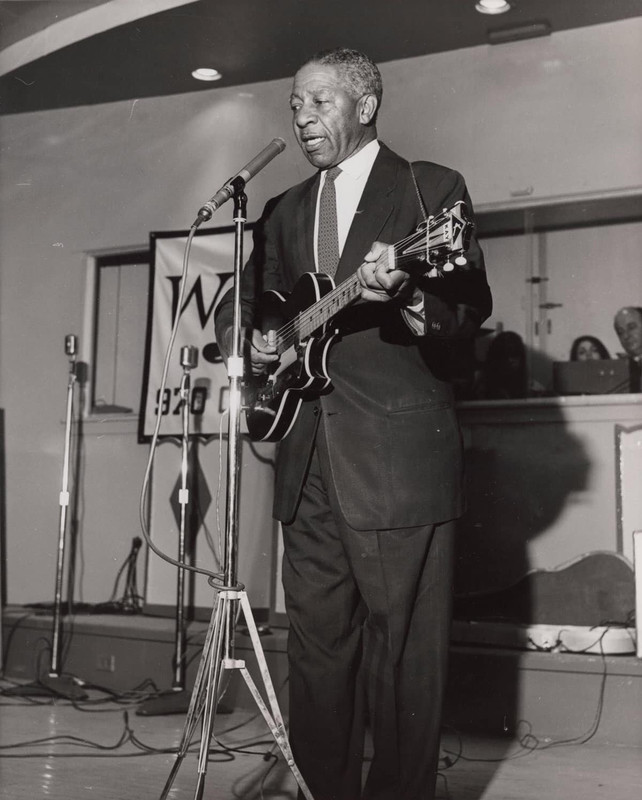
“Lonnie Johnson was the most influential guitarist of the 20th century.” - B.B. King.

“Lonnie Johnson was the most influential guitarist of the 20th century.” - B.B. King.
SpoilerShow
“Johnson made his first recording on November 2, 1925, as a singer and violinist on the Jazz-O-Maniacs’ “Won’t Don’t Blues.” That same week he inaugurated his own recording career on the OKeh label with his guitar instrumental “Mr. Johnson’s Blues” and its flip side, “Falling Rain Blues,” on which he sang and played violin. Over the next seven years, Johnson recorded more than 130 selections for OKeh and various other phonograph companies, including “Ball and Chain Blues” (1926), “Roaming Rambler Blues” (1927), “Away Down in the Alley Blues” (1928), “She’s Making Whoopee in Hell Tonight” (1927), “There Is No Justice” (1932), and “Racketeer’s Blues” (1932), making him one of the most extensively recorded bluesmen of his generation. His music often addressed the daily experiences and hard times of urban, working-class African Americans, especially recently arrived southern migrants. “My blues is built on human beings on land,” he once explained. “See how they live, see their heartaches and the shifts they go through with love affairs and things like that—that’s what I write about and that’s the way I make my living.”
“An extremely versatile musician who played several stringed instruments, Johnson worked extensively for OKeh Records as a studio musician between 1925 and 1932. He not only played guitar on the recordings of such blues musicians as Alger “Texas” Alexander, Victoria Spivey, and Clara Smith, but also accompanied jazz bands: in 1927 he recorded with Louis Armstrong’s Hot Five (“I’m Not Rough,” “Hotter than That,” and “Savoy Blues”) and the following year with Duke Ellington and His Orchestra (“The Mooche” and “Misty Morning”). Of particular note is the series of spectacular guitar duets that Johnson recorded in the late 1920s with famed jazz guitarist Eddie Lang, including such classics as “A Handful of Riffs,” “Hot Fingers,” and “Bull Frog Moan,” all of which were recorded in 1929.”
“After slumping record sales during the early years of the Great Depression prematurely derailed his recording career, Johnson drifted in and out of the musical profession.” - The Missouri Encyclopedia.
“An extremely versatile musician who played several stringed instruments, Johnson worked extensively for OKeh Records as a studio musician between 1925 and 1932. He not only played guitar on the recordings of such blues musicians as Alger “Texas” Alexander, Victoria Spivey, and Clara Smith, but also accompanied jazz bands: in 1927 he recorded with Louis Armstrong’s Hot Five (“I’m Not Rough,” “Hotter than That,” and “Savoy Blues”) and the following year with Duke Ellington and His Orchestra (“The Mooche” and “Misty Morning”). Of particular note is the series of spectacular guitar duets that Johnson recorded in the late 1920s with famed jazz guitarist Eddie Lang, including such classics as “A Handful of Riffs,” “Hot Fingers,” and “Bull Frog Moan,” all of which were recorded in 1929.”
“After slumping record sales during the early years of the Great Depression prematurely derailed his recording career, Johnson drifted in and out of the musical profession.” - The Missouri Encyclopedia.
Re: Η Φωτογραφία της ημέρας.
John Lee Hooker.

“You can’t handle success if you ain’t paid some dues. Some of them get the big heads, the ego-trip — you can’t talk to ’em. If you got it the hard way, you know how you got it. You appreciate the people that put you there at the top. You look at your public. They is the one that put you where you is at. That’s why I’m always takin] time out to talk to my fans, have a little drink with them or whatever” - John Lee Hooker.

“You can’t handle success if you ain’t paid some dues. Some of them get the big heads, the ego-trip — you can’t talk to ’em. If you got it the hard way, you know how you got it. You appreciate the people that put you there at the top. You look at your public. They is the one that put you where you is at. That’s why I’m always takin] time out to talk to my fans, have a little drink with them or whatever” - John Lee Hooker.
Re: Η Φωτογραφία της ημέρας.
Hubert Sumlin.
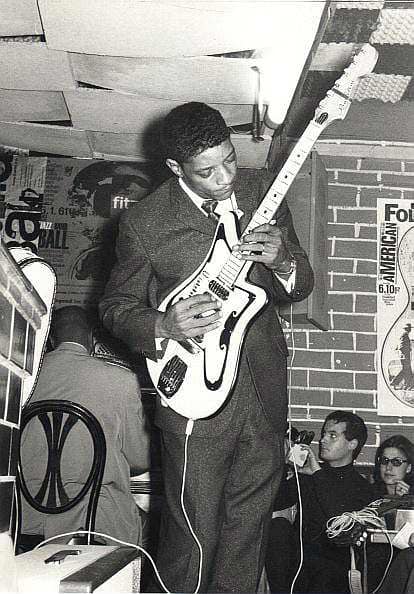
From a Guitar World interview…
GW: “One unusual aspect of your style is that you don’t play a lot of chords.”
HS: “No, I don’t, but I play a lot of tricks. Like Muddy Waters once said, I’ve got a lot of gimmicks up my sleeves. I know when to get in and when to get out. Lots of guitarists just miss out on that aspect of playing. I know how and where to put it, which is what it’s all about.”

From a Guitar World interview…
GW: “One unusual aspect of your style is that you don’t play a lot of chords.”
HS: “No, I don’t, but I play a lot of tricks. Like Muddy Waters once said, I’ve got a lot of gimmicks up my sleeves. I know when to get in and when to get out. Lots of guitarists just miss out on that aspect of playing. I know how and where to put it, which is what it’s all about.”
Re: Η Φωτογραφία της ημέρας.
Sister Rosetta Tharpe.
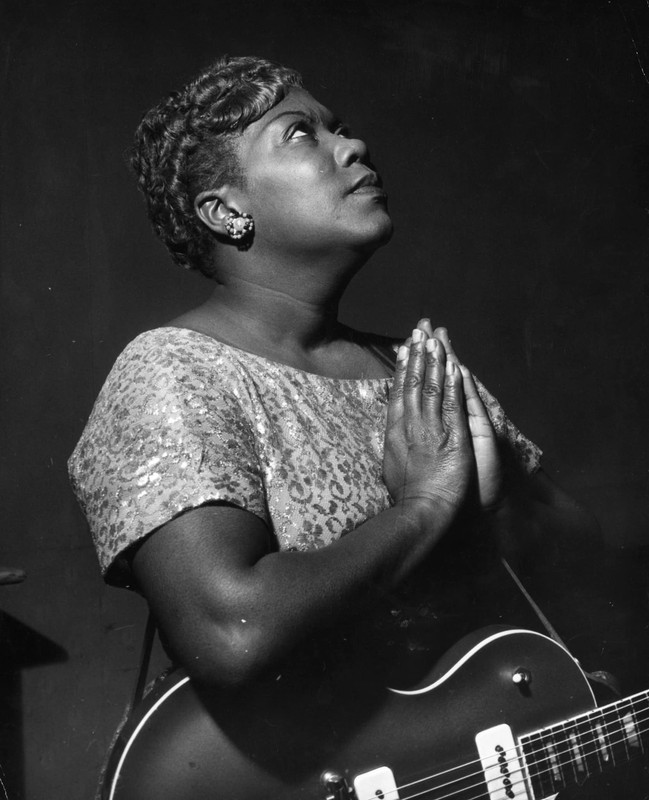
“She traveled the world and left it scorched with her fearlessness and musical originality, inspired fierce devotion from an audience who thrilled to her enormous gifts and her personal excesses, and shook the celestial rafters with the force of her artistic character. She was also my dad’s favorite singer.
Sister Rosetta Tharpe was born in 1915 in Cotton Plant, Arkansas, at the edge of the Mississippi Alluvial Plain, one hundred and twenty miles northeast of where my dad was born seventeen years later in Kingsland, Arkansas. Sometimes he would shake his head and muse during odd or inexplicable events, “Strange things are happening every day,” which was a nod to the title of her most famous song. “Strange Things Happening Every Day” was a hit for her in 1945 and reached No. 2 on the “race” chart in Billboard magazine, the precursor of the Rhythm and Blues chart.
She was a musical prodigy who sang, played guitar, and performed gospel songs in the Black Pentecostal church from the age of four, then traveled with her mother around the South, performing in churches as Little Rosetta Nubin, billed as the “Singing and Guitar Playing Miracle.”
She became Sister Rosetta Tharpe in 1938, after leaving her first husband, Thomas J. Tharpe, and moving with her mother to New York City, by way of Chicago.” - Rosanne Cash.

“She traveled the world and left it scorched with her fearlessness and musical originality, inspired fierce devotion from an audience who thrilled to her enormous gifts and her personal excesses, and shook the celestial rafters with the force of her artistic character. She was also my dad’s favorite singer.
Sister Rosetta Tharpe was born in 1915 in Cotton Plant, Arkansas, at the edge of the Mississippi Alluvial Plain, one hundred and twenty miles northeast of where my dad was born seventeen years later in Kingsland, Arkansas. Sometimes he would shake his head and muse during odd or inexplicable events, “Strange things are happening every day,” which was a nod to the title of her most famous song. “Strange Things Happening Every Day” was a hit for her in 1945 and reached No. 2 on the “race” chart in Billboard magazine, the precursor of the Rhythm and Blues chart.
She was a musical prodigy who sang, played guitar, and performed gospel songs in the Black Pentecostal church from the age of four, then traveled with her mother around the South, performing in churches as Little Rosetta Nubin, billed as the “Singing and Guitar Playing Miracle.”
She became Sister Rosetta Tharpe in 1938, after leaving her first husband, Thomas J. Tharpe, and moving with her mother to New York City, by way of Chicago.” - Rosanne Cash.
Re: Η Φωτογραφία της ημέρας.
Johnny Shines.
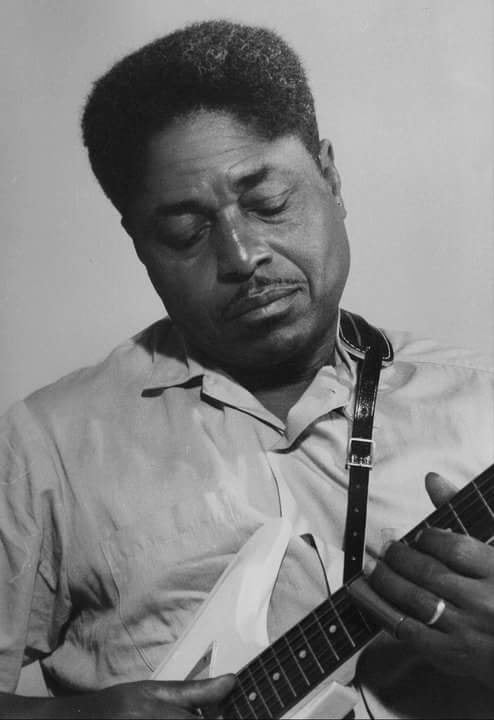
"Best known as a traveling companion of Robert Johnson, Johnny Shines' own contributions to the blues have often been unfairly shortchanged, simply because Johnson's own legend casts such a long shadow. In his early days, Shines was one of the top slide guitarists in Delta blues, with his own distinctive, energized style; one that may have echoed Johnson's spirit and influence, but was never a mere imitation. Shines eventually made his way north to Chicago, and made the transition to electrified urban blues with ease, helped in part by his robust, impassioned vocals. He was vastly under-recorded during his prime years, even quitting the music business for a time, but was rediscovered in the late '60s and recorded and toured steadily for quite some time. A 1980 stroke robbed him of some of his dexterity on guitar, but his voice remained a powerfully emotive instrument, and he performed up until his death in 1992." - Steve Huey.

"Best known as a traveling companion of Robert Johnson, Johnny Shines' own contributions to the blues have often been unfairly shortchanged, simply because Johnson's own legend casts such a long shadow. In his early days, Shines was one of the top slide guitarists in Delta blues, with his own distinctive, energized style; one that may have echoed Johnson's spirit and influence, but was never a mere imitation. Shines eventually made his way north to Chicago, and made the transition to electrified urban blues with ease, helped in part by his robust, impassioned vocals. He was vastly under-recorded during his prime years, even quitting the music business for a time, but was rediscovered in the late '60s and recorded and toured steadily for quite some time. A 1980 stroke robbed him of some of his dexterity on guitar, but his voice remained a powerfully emotive instrument, and he performed up until his death in 1992." - Steve Huey.
Re: Η Φωτογραφία της ημέρας.
Mississippi John Hurt.
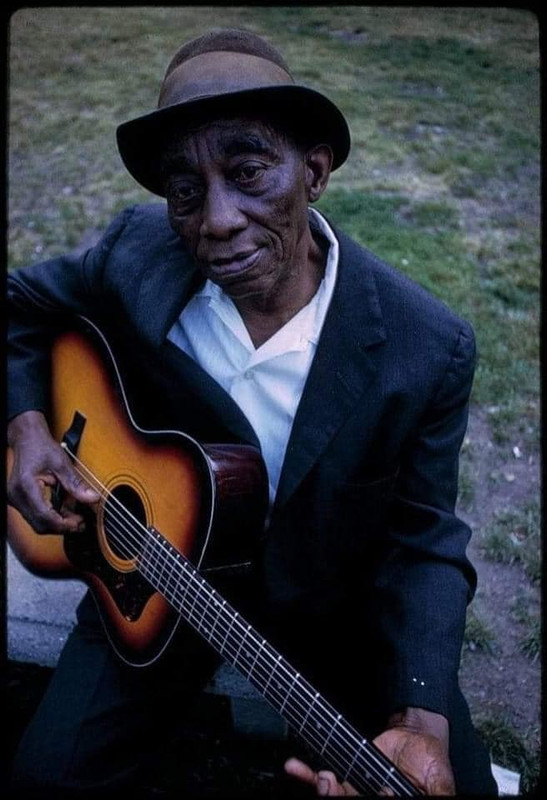
Mississippi John Hurt made his first recordings in the late 1920’s. They were commercial failures, and he returned to the life of a farmer. He was then rediscovered in 1963…
“Hurt’s performance at the 1963 Newport Folk Festival, made him an immediate star. He became one of the first original blues artists to play the college and coffee house circuit, a full year before the ‘rediscovery’ of Son House. From 1963 until his death on November 2nd, 1966, he recorded three full albums for the Vanguard label, recorded the majority of his repertoire for the Library of Congress, and toured extensively with other artists including Mississippi Fred McDowell, Elizabeth Cotten, Rev. Gary Davis, John Lee Hooker, Brownie McGhee, and Sonny Terry. He even appeared on The Tonight Show, with then host, Johnny Carson.” - JD Nash.

Mississippi John Hurt made his first recordings in the late 1920’s. They were commercial failures, and he returned to the life of a farmer. He was then rediscovered in 1963…
“Hurt’s performance at the 1963 Newport Folk Festival, made him an immediate star. He became one of the first original blues artists to play the college and coffee house circuit, a full year before the ‘rediscovery’ of Son House. From 1963 until his death on November 2nd, 1966, he recorded three full albums for the Vanguard label, recorded the majority of his repertoire for the Library of Congress, and toured extensively with other artists including Mississippi Fred McDowell, Elizabeth Cotten, Rev. Gary Davis, John Lee Hooker, Brownie McGhee, and Sonny Terry. He even appeared on The Tonight Show, with then host, Johnny Carson.” - JD Nash.
Re: Η Φωτογραφία της ημέρας.
Blind Willie McTell.
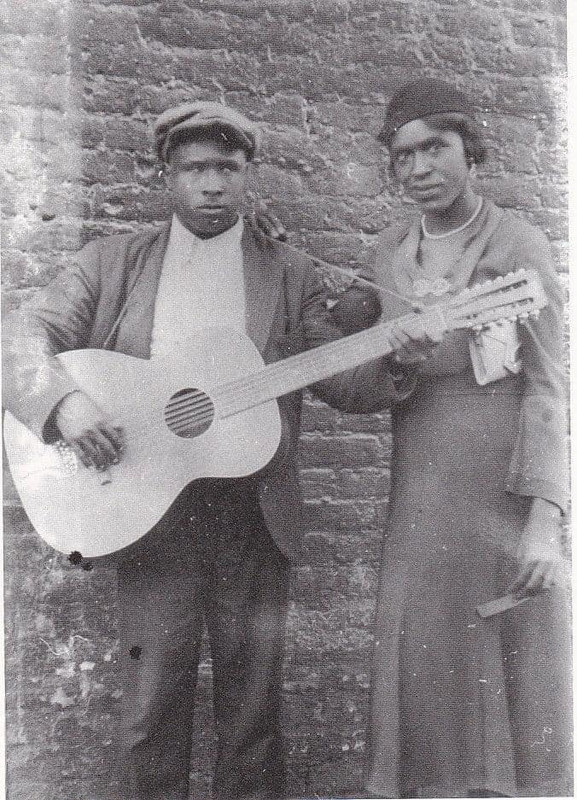
This photo was taken in 1934. Willie is holding a 12-string acoustic guitar, and his wife Kate is standing beside him.
“Blind Willie McTell was a Piedmont blues and ragtime singer and guitarist. He played with a fluid, syncopated fingerstyle guitar technique, common among many exponents of Piedmont blues.
Unlike his contemporaries, he came to use twelve-string guitars exclusively. McTell was also an adept slide guitarist, unusual among ragtime bluesmen. His vocal style, a smooth and often laid-back tenor, differed greatly from many of the harsher voices of Delta bluesmen such as Charley Patton. McTell performed in various musical styles, including blues, ragtime, religious music and hokum”.

This photo was taken in 1934. Willie is holding a 12-string acoustic guitar, and his wife Kate is standing beside him.
“Blind Willie McTell was a Piedmont blues and ragtime singer and guitarist. He played with a fluid, syncopated fingerstyle guitar technique, common among many exponents of Piedmont blues.
Unlike his contemporaries, he came to use twelve-string guitars exclusively. McTell was also an adept slide guitarist, unusual among ragtime bluesmen. His vocal style, a smooth and often laid-back tenor, differed greatly from many of the harsher voices of Delta bluesmen such as Charley Patton. McTell performed in various musical styles, including blues, ragtime, religious music and hokum”.
Re: Η Φωτογραφία της ημέρας.
Reverend Gary Davis.
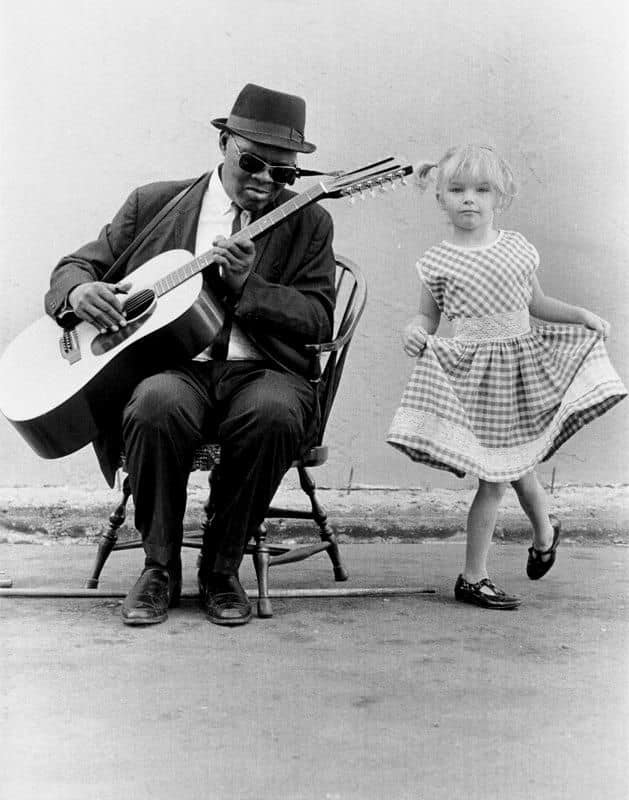
“The Reverend Gary Davis was a blues and gospel singer who was also proficient on the banjo, guitar and harmonica. Born in Laurens, South Carolina and blind since infancy, Davis first performed professionally in the Piedmont blues scene of Durham, North Carolina in the 1930s, before converting to Christianity and becoming a minister. After relocating to New York in the 1940s, Davis experienced a career rebirth as part of the American folk music revival that peaked during the 1960s”. The little girl is Megan Ochs. Alice Ochs, her mother, took the picture.

“The Reverend Gary Davis was a blues and gospel singer who was also proficient on the banjo, guitar and harmonica. Born in Laurens, South Carolina and blind since infancy, Davis first performed professionally in the Piedmont blues scene of Durham, North Carolina in the 1930s, before converting to Christianity and becoming a minister. After relocating to New York in the 1940s, Davis experienced a career rebirth as part of the American folk music revival that peaked during the 1960s”. The little girl is Megan Ochs. Alice Ochs, her mother, took the picture.
-
- Παραπλήσια Θέματα
- Απαντήσεις
- Προβολές
- Τελευταία δημοσίευση
-
- 1 Απαντήσεις
- 407 Προβολές
-
Τελευταία δημοσίευση από Σιχαμερίων Αθλιοζήλευτος
15 Σεπ 2023, 17:32
-
- 33 Απαντήσεις
- 3227 Προβολές
-
Τελευταία δημοσίευση από Ναύτης
13 Δεκ 2023, 08:22
-
-
Νέα δημοσίευση Η μαλάκω της ημέρας
από Σιχαμερίων Αθλιοζήλευτος » 23 Μάιος 2023, 12:47 » σε Κοινωνικά θέματα - 42 Απαντήσεις
- 2443 Προβολές
-
Τελευταία δημοσίευση από Aitwlos
23 Οκτ 2024, 21:38
-
-
- 288 Απαντήσεις
- 6313 Προβολές
-
Τελευταία δημοσίευση από aLiCat
05 Μαρ 2024, 15:13
